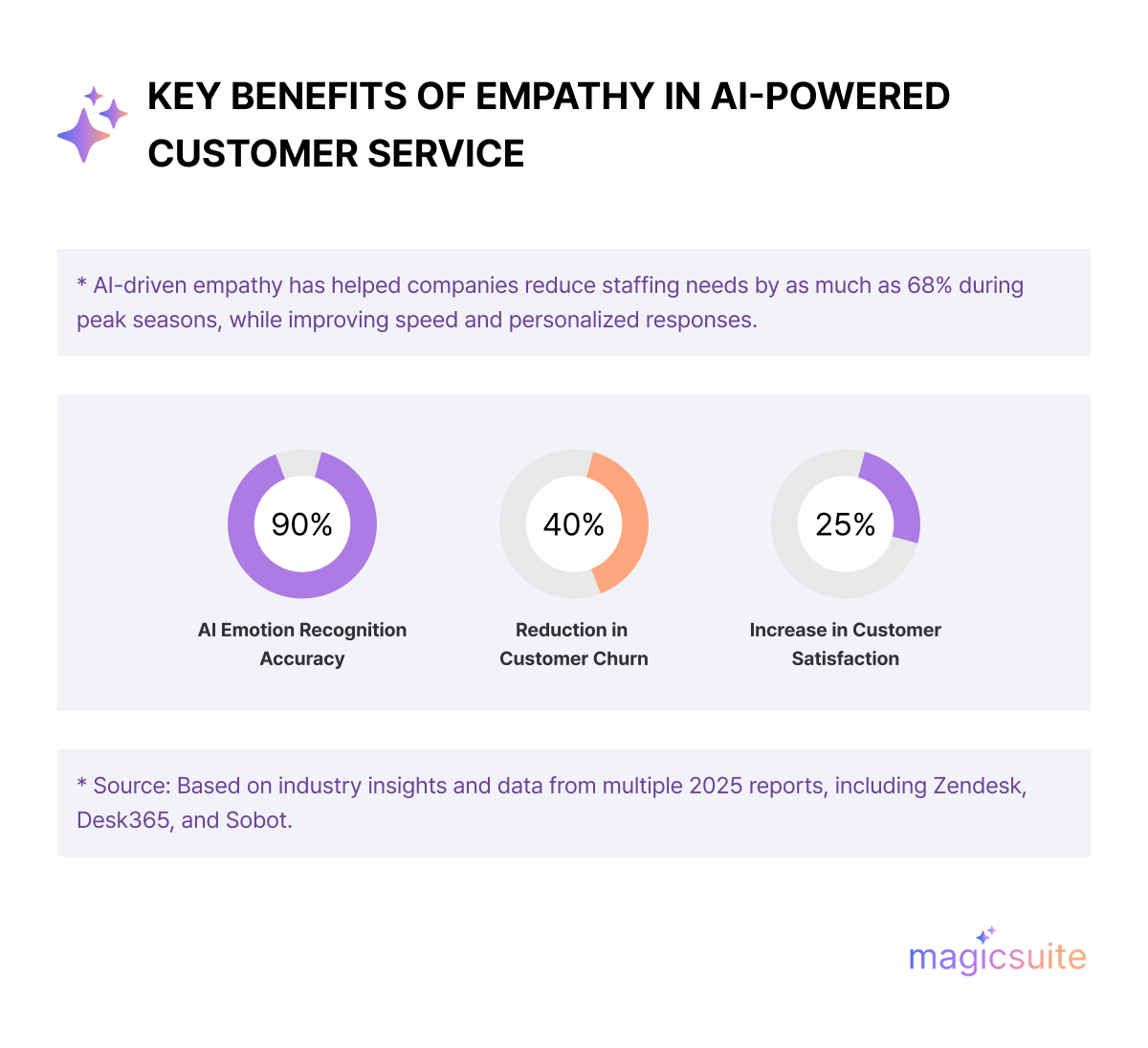Explore how AI simulates empathy in customer service through NLP and sentiment analysis. Learn about real-world success, limitations, ethical concerns, and why AI + human agents create the most effective empathetic support.

Empathy means knowing, understanding, and sharing how someone else feels. It is very important for great customer service. Today’s customers want fast solutions, but they also want to feel truly understood when they are upset or frustrated.
AI chatbots can help many customers at once and give steady service. But can they really show true empathy in gen ai chatbots?
This article looks at how AI and empathy work together. It uses real-world examples, research studies, and facts from the industry. We also share the best ways to use “artificial empathy” and talk about the right and wrong ways to do it.
Main Takeaway: AI can often simulate and surpass human empathy in scripted situations, but genuine service depends on customer perceptions, contextual authenticity, and ethical considerations.
Empathy in customer service refers to the ability to understand and share the feelings of a customer, especially when they are frustrated, confused, or upset. It’s not just about solving a problem but about making the customer feel heard and valued.
According to a 2023 report by PwC, 59% of customers feel that companies have lost touch with the human element of customer experience, emphasizing the need for empathy in customer service.

Key Elements of Empathy in Customer Service:
These human-centric traits are difficult to replicate with code—but not impossible.
AI empathy refers to artificial intelligence systems designed to recognize, interpret, and respond to human emotions in a way that mimics empathy. This is achieved through a combination of:
Companies like IBM Watson and Microsoft Azure Cognitive Services are leading the charge in developing AI that can detect emotional cues from text, speech, and even facial expressions.
Example:

A study published in the journal Nature Machine Intelligence by Stanford researchers found that AI models trained on large datasets could detect emotional tone in text with 85% accuracy, nearly matching human performance.
MIT’s Media Lab also conducted a study on the use of emotionally intelligent AI in call centers. The AI was able to detect stress levels in customer voices and adapt its responses accordingly. Results showed a 20% increase in customer satisfaction when AI was used to assist human agents.
A 2022 meta-analysis published in JAIR examined 42 research papers about AI showing empathy. It found that AI can copy how people show empathy by using words and tone, but it doesn’t feel emotions like humans do.
Even so, in 68% of the cases, customers couldn’t tell if the empathetic response came from AI or a real person. This means AI is getting very good at sounding caring, even though it doesn’t truly understand feelings.
If you think empathetic AI is impossible in customer service, here are real-world examples showcasing the role of empathy in AI.
KLM uses a chatbot named “BB” (BlueBot) that employs NLP and sentiment analysis to assist customers on Facebook Messenger. BB is trained to recognize frustration and escalate to a human agent when necessary. KLM reported a 40% reduction in response time and a 15% increase in customer satisfaction.
H&M’s AI assistant uses conversational AI to help customers find clothing items. It adjusts its tone based on customer input. If a user expresses dissatisfaction, the bot responds with more empathetic language and offers personalized recommendations.
Cogito is an AI-powered tool used in call centers that provides real-time emotional intelligence feedback to human agents. It analyzes voice tone and pace, suggesting when to slow down, show empathy, or offer reassurance. According to Cogito, companies using their software saw a 28% improvement in customer satisfaction.
Despite impressive advancements, AI still faces significant challenges in delivering genuine empathy.
AI does not "feel" emotions. It can simulate empathetic responses, but it doesn’t experience empathy. This can lead to inauthentic interactions, especially in emotionally charged situations like bereavement or medical emergencies.
Empathy is deeply cultural. A phrase that’s comforting in one culture may be offensive in another. AI systems often struggle with these nuances.
Many AI systems rely on pre-programmed scripts. While these can be effective, they may fail when customers deviate from expected behavior or use sarcasm, slang, or idioms.
To detect emotions accurately, AI often needs access to sensitive data such as voice recordings or facial expressions. This raises ethical questions about data privacy and consent.

Even with advanced technology, AI can reflect and amplify human biases. In controlled experiments, GPT-4 showed gender bias, displaying more empathy toward female personas. In healthcare, mental health chatbots showed a 12% increase in user engagement when empathy algorithms were active, though caution is needed for sensitive populations.
Here are some of the best practices that you can implement in your business to start delivering empathy in customer service:
Incorporate these practices, and you can maximize the effectiveness of AI and empathy in your customer service operations. For a powerful tool that embodies these principles, consider exploring MagicTalk.
The most promising future lies in hybrid models where AI assists human agents by:
This approach combines the efficiency of AI with the emotional depth of human agents. Affective computing is also an advancing field pioneered by MIT’s Rosalind Picard. It aims to develop systems that can recognize and respond to human emotions. With the rise of deep learning and multimodal AI, machines are becoming more adept at interpreting complex emotional states.
Organizations like the AI Now Institute and Partnership on AI are working to ensure that empathetic AI is developed ethically, with transparency and accountability.
MagicTalk helps deliver empathy in AI customer service by quickly sending hard questions to human agents. MagicTalk uses AI to answer easy questions fast. When it notices a customer is upset or the problem is complex, it immediately passes the chat to a real person.
MagicTalk also helps human agents by giving them useful tips and information during chats. It reads the customer’s tone and suggests the best way to reply with care.
In short, MagicTalk makes sure:
This mix of AI and humans gives the best customer service with both speed and true understanding.
AI can detect and interpret emotional cues using data, but it does not experience emotions. It mimics empathy through pattern recognition and programmed responses.
Yes, in many cases. A study by Capgemini found that 54% of customers felt emotionally connected to brands that used empathetic AI in customer service.
Not entirely. AI is augmenting human agents, not replacing them. Hybrid models are proving most effective in delivering both efficiency and emotional intelligence.
AI may never really “feel” empathy like people do. But it can learn to notice how people feel and reply in ways that make customers feel heard and cared for. Using tools like natural language processing, sentiment analysis, and real-time feedback, AI that shows empathy is already changing customer service in many fields.
The important part is balance: using AI for fast, steady help, while keeping real people involved for true feelings and honest care. As technology gets better, so will what we expect. Soon, empathetic AI might be needed to give great customer experiences.

Luke is a technical market researcher with a deep passion for analyzing emerging technologies and their market impact. With a keen eye for data and trends, Luke provides valuable insights that help shape strategic decisions and product innovations. His expertise lies in evaluating industry developments and uncovering key opportunities in the ever-evolving tech landscape.